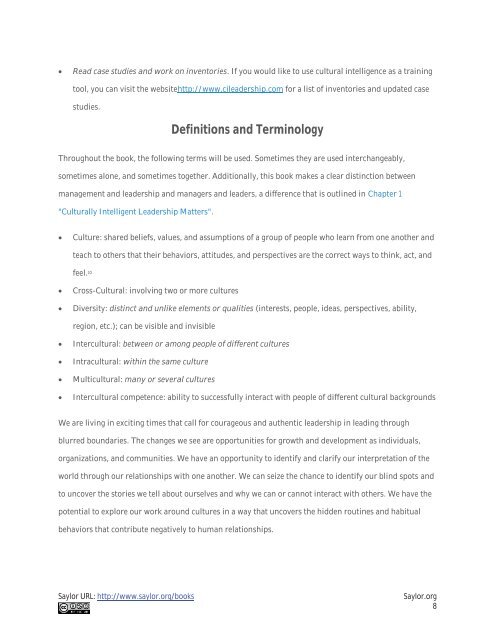Leading with Cultural Intelligence, 2012a
Leading with Cultural Intelligence, 2012a
Leading with Cultural Intelligence, 2012a
You also want an ePaper? Increase the reach of your titles
YUMPU automatically turns print PDFs into web optimized ePapers that Google loves.
Read case studies and work on inventories. If you would like to use cultural intelligence as a training<br />
tool, you can visit the websitehttp://www.cileadership.com for a list of inventories and updated case<br />
studies.<br />
Definitions and Terminology<br />
Throughout the book, the following terms will be used. Sometimes they are used interchangeably,<br />
sometimes alone, and sometimes together. Additionally, this book makes a clear distinction between<br />
management and leadership and managers and leaders, a difference that is outlined in Chapter 1<br />
"<strong>Cultural</strong>ly Intelligent Leadership Matters".<br />
<br />
Culture: shared beliefs, values, and assumptions of a group of people who learn from one another and<br />
teach to others that their behaviors, attitudes, and perspectives are the correct ways to think, act, and<br />
feel. 10<br />
<br />
<br />
Cross-<strong>Cultural</strong>: involving two or more cultures<br />
Diversity: distinct and unlike elements or qualities (interests, people, ideas, perspectives, ability,<br />
region, etc.); can be visible and invisible<br />
<br />
<br />
<br />
<br />
Intercultural: between or among people of different cultures<br />
Intracultural: <strong>with</strong>in the same culture<br />
Multicultural: many or several cultures<br />
Intercultural competence: ability to successfully interact <strong>with</strong> people of different cultural backgrounds<br />
We are living in exciting times that call for courageous and authentic leadership in leading through<br />
blurred boundaries. The changes we see are opportunities for growth and development as individuals,<br />
organizations, and communities. We have an opportunity to identify and clarify our interpretation of the<br />
world through our relationships <strong>with</strong> one another. We can seize the chance to identify our blind spots and<br />
to uncover the stories we tell about ourselves and why we can or cannot interact <strong>with</strong> others. We have the<br />
potential to explore our work around cultures in a way that uncovers the hidden routines and habitual<br />
behaviors that contribute negatively to human relationships.<br />
Saylor URL: http://www.saylor.org/books<br />
Saylor.org<br />
8


















